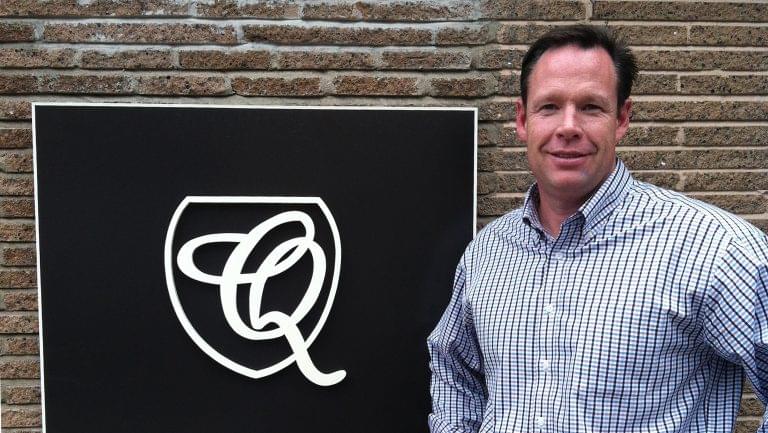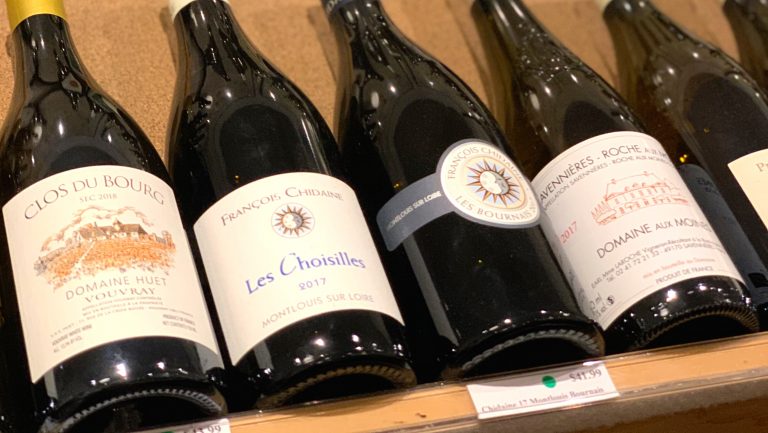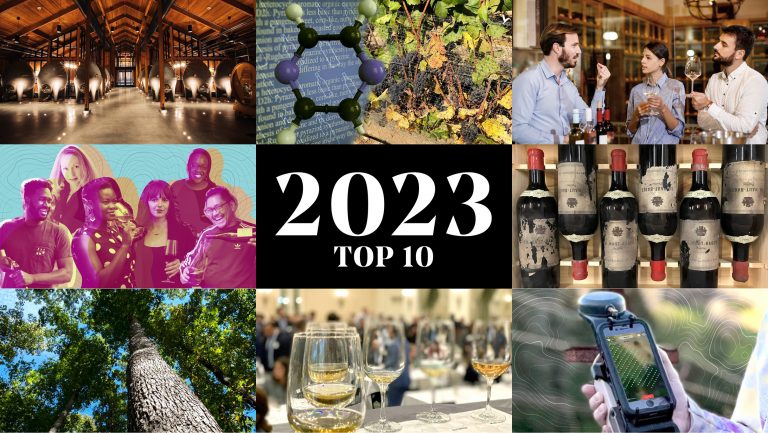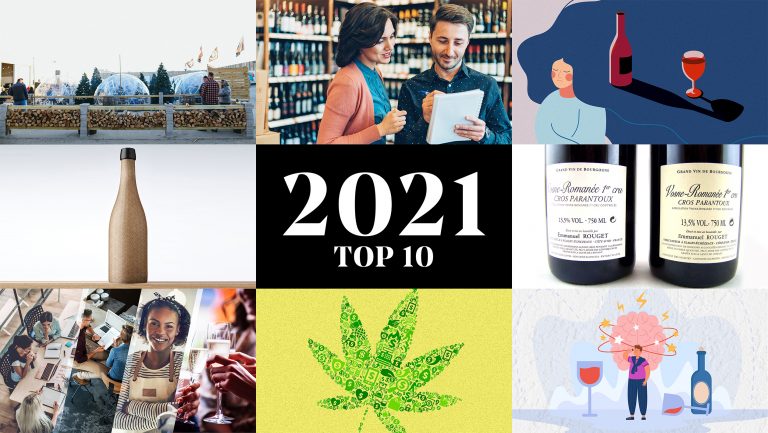On October 2, Dennis Kreps found himself in a very uncomfortable position.
That day, the U.S. Trade Representative (USTR), an office of the executive branch of the United States, announced that it would impose 25 percent tariffs on a long list of agricultural imports from European Union nations. The list included nonsparkling wines from France, Germany, Spain, and Great Britain, up to 14 percent alcohol by volume. The taxes went into effect for any earmarked items clearing customs starting October 18, which gave American importers just two weeks to prepare. “They had our undivided attention,” Kreps recalls grimly.
Kreps is a cofounder of the import, marketing, and sales firm Quintessential Wines, based in Napa, California, and the exclusive American agent for the Beaujolais powerhouse Les Vins Georges Duboeuf and approximately 37 other family domaines in Beaujolais. His bread and butter is Beaujolais Nouveau Day—November 21 this year—when über-fresh wines from the central French wine region are released all over the world, with great fanfare.

Don’t miss the latest drinks industry news and insights. Sign up for our award-winning newsletters and get insider intel, resources, and trends delivered to your inbox every week.
Vinified quickly from the just-harvested vintage, the Nouveau wines were on their way to bottling by early October, by which time Kreps’s sales team had already set prices and inked agreements. “Our program was completely put together, wrapped up, and finalized before the tariffs were announced,” Kreps says, “but the tariffs would be applied to wines arriving in the third week of November.” He couldn’t jack up prices, he points out, because if customers were to balk and cancel orders, “we couldn’t just put the wine back into inventory and sell it six months later, because it’s Nouveau.”
Kreps says his distributors and producers agreed to absorb some of the financial burden, and Quintessential will weather the storm thanks to the wines in his book that clock in above 14.1% ABV and hail from nations not affected by the taxes. “I am incredibly relieved,” he says, “that we have a diversified portfolio.”

Mitigating the Pain with Multipronged Responses
Kreps is just one of many American beverage professionals who are scrambling to regroup after being slapped with the 25 percent tax on imports. Importers, wholesalers, and retailers had been bracing for a trade war with the EU for months, and 10 prominent American industry groups released a statement in August citing the severe economic impact and lost jobs that would result from the penalties. Still, the beverage industry was shell shocked by the October 2 announcement that the United States had won the largest arbitration award in World Trade Organization (WTO) history in its dispute with the EU over illegal subsidies to Airbus—and thus the right to impose countermeasures against the EU.
“I just got a text from one of my whisky reps with a new price sheet for the Scotch he carries,” says Joseph Maritato, the co-owner of The Whiskey Ward tavern in Manhattan’s Lower East Side neighborhood. “From what it looks like, bottles in the $50 range are going up about $10 a bottle, and bottles in the $100 range are going up around $18 to $20. I’m just digesting it right now … and that’s just from one Scotch portfolio.” In an October 18 statement, Karen Betts, the chief executive of the Edinburgh-based Scotch Whisky Association, said that whisky producers alone will be assuming more than 60 percent of the U.K.’s overall tariff bill, and she predicted that whisky exports to the U.S. will drop by as much as 20 percent over the coming year. And the effort to penalize the United Kingdom has, in fact, come back to hurt American small business owners like Maritato. “I am definitely not happy about this at all,” he says. “Nobody should be.”
The French and Spanish wine industries, too, have been hit particularly hard, since the U.S. accounts for 18 and 12 percent, respectively, of those nations’ exports. And the small American import firms that bring in wines from these nations—wines that tend to be below the 14% ABV cutoff—are reeling.
Olivier Rochelois, an importer in Portland, Oregon, whose boutique Petit Monde firm focuses on food-friendly French wines that tend to be lower in alcohol, sent a letter to clients on November 1 in which he vowed to keep pass-through price hikes to a minimal 4 to 5 percent by, in part, reducing margins—including reducing commissions for himself and his four employees, to offset price bumps—and spreading price increases across his book, including selections from Italy. “We feel the distinction between what wines are taxed at an additional 25 percent or not is arbitrary,” Rochelois wrote, “and this spreading of the load allows us to significantly reduce the impact per wine.”

“Regardless of whether you are talking about farmers, importers, wine shops, or wine consumers, this tariff will be extremely difficult to absorb for an extended period of time,” says Whitney Schubert, the manager of the French wine portfolio at the New York City–based importer and wholesaler Polaner Selections.
Schubert’s initial strategy for dealing with the additional tax was to focus on the 14.1% ABV cutoff. “Our first step was to get the exact updated alcohol percentage of every wine from every producer,” she says. “We were curious as to whether or not there were wines that, after years at a certain alcohol level, had changed due to the impact of climate change.” Quite a few Southern French wines, it turned out, had crept up in alcohol, and after a warm 2018 vintage, “even some of the Loire producers we work with came out at 14.2%.” By reapplying for label approval, these producers will gain exemptions from the tariffs. (It should be noted that U.S. customs agents are randomly testing shipments for ABV levels, so fudging the numbers is not an option.)
“What’s additionally challenging,” says Schubert, “is that for a lot of wine growers, their larger-production wines are their lowest-margin wines. We are going producer by producer, wine by wine to strategize … We are having a lot of difficult conversations with growers about the reality of how this will affect sales.”
An Airline Trade War Hurts Small Farmers
The tariffs arise not from the wine and spirits industries but from the dispute between the world’s two top airline manufacturers. The schism dates back to 2004, when Boeing alleged that the EU broke WTO rules by subsidizing the Airbus corporation, to the disadvantage of its American rival. With Airbus production plants and corporate offices located in France, Germany, Spain, and the U.K., these nations were targeted, leaving Italian, Austrian, and Portuguese wines unscathed.
But aircraft-related products from France, Germany, Spain, and the U.K. have only been hit with a 10 percent tariff, while artisan farm products like olive oil, cheese, and wine are being slapped with the 25 percent tax. (Nations like Italy, which were spared the wine tax, are still subject to the tariff on other food products, such as cheese.) “The producers, as you can imagine, are frustrated to be caught up in a dispute between Airbus and Boeing that is long standing and is truly separate from their activity,” says F. Dixon Brooke, the president of the Kermit Lynch Wine Merchant import firm.
There appears to be an anti-culture sentiment behind the sanctions, which hurt producers of photographs and lithographs as well. Indeed, according to Mike Veseth, the editor of The Wine Economist, European wine was specifically targeted because of its cultural significance. “It sends a message to particular politicians or groups,” he says, adding that the victims of trade wars are “often symbolic or political.”
By similar reasoning, in retaliation for President Trump’s 25 percent import duty on steel and 10 percent duty on aluminium, Europe and Mexico imposed a 25 percent duty on exports of American whiskey and bourbon in Spring 2018.
The tit-for-tat trade war shows no sign of abating. The EU has as much as stated that it will impose counter-tariffs on the U.S. in retaliation for the October 18 taxes, as the WTO is due to award the EU damages soon in a parallel airline trade case in which Airbus has accused the U.S. of offering illegal subsidies to Boeing.
The pain of the economic victims—whether American or European—seems to be pointless. Until last year, wine and spirits were traded fairly freely between the U.S. and the EU, with low to no tariffs, to the benefit of both. It is disturbing, too, that Boeing, which has been accused of gross negligence and recklessness after two recent fatal crashes of its 737 Max jets, should be wielding such power over the world’s economy.
Inexplicable Exemptions
Between bouts of panic and despair, American beverage professionals are spending their free time theorizing about the decision making that went into the new rules. Numerous importers suggested to me, half-jokingly, that the fact that wines measuring above 14% ABV are exempt from the tax seems, in a twisted way, to reward the effects of climate change.
Curiously, sparkling wine, too, is omitted from the tariffs. Multiple media outlets have speculated that the opening in mid-October of a Louis Vuitton handbag factory near Dallas may have had something to do with this exclusion—President Trump and his daughter Ivanka, as well as the LVMH chairman, Bernard Arnault, attended the opening ceremonies.
LVMH’s holdings are heavily invested in Champagne houses, which include its namesake Moët & Chandon—parent to the Dom Pérignon brand—Krug, Ruinart, and Veuve Clicquot, as well as Hennessy Cognac, another category not affected by the taxes. Handbags, too, were on an original list of proposed targets but managed to avoid the final tax. (That said, the prominent Scotch whisky brands Ardbeg and Glenmorangie, subject to the tax, are also part of the LVMH portfolio.)
Whatever the reason for it, importers and wholesalers are considering the sparkling-wine exemption to be a small gift, given that promotions, campaigns, and price lists for sparkling wines were set well in advance of the holiday season.
Another exemption, oddly, is bulk wine shipped in quantities of two liters or more, suggesting the possibility of getting around the sanctions by importing wine in large quantities and bottling it in the U.S. Most of the quality-oriented importers I spoke with aren’t considering this option. Bulk wine, they tell me, has long been subject to its own byzantine shipping laws and duties, isn’t permitted to be exported from some European appellations, and is overall too complex of a business to get into.
In addition, the idea “raises technical issues,” says Kirk Wille, the vice president of the import and wholesale firm Loosen Bros. USA, which focuses on German wines. His firm’s proprietors, Ernst and Thomas Loosen, are “quite cautious about shipping in bulk because of general quality concerns, such as loss of aromatics, freshness, and CO2 in transport, and the possibility of microbial contamination in bottling facilities that they can’t oversee personally.”
Still, adds Wille, before the tariffs were announced, Loosen Bros. had been experimenting with shipping an off-dry (“feinherb” style) Riesling from its Dr. L brand in 1,000-liter bulk containers for kegging in the U.S., and they may expand this program if the sanctions persist. “It’s a small project so far,” says Wille, “and this particular wine has fairly low residual sweetness, but this will give us a chance to see how well bulk shipment works for us. We do like the lower carbon footprint of shipping in bulk for bottling in-country, but we will only do it if Erni and Thomas are satisfied that the process doesn’t diminish the quality and character of the wines.”
Will Hardship Spur Industry Efficiency?
While a sense of dejection has settled over much of the industry, some are staying positive. “Tariffs on French, German, and Spanish wines are not discouraging my type of clients, who are willing to pay a premium on something that comes from Europe,” says Riccardo Guerrieri, the general manager at Vinology Bottle Shop & Tasting Bar in the tony West University neighborhood of Houston.
Edward Holl, the chairman and CEO of First Growth Brands—a producer and importer of premium European wines through exclusive partnerships—believes that his low-cost business model will carry him through this rough spot and that the tariffs can be absorbed along his value chain. “Our strategy is to put $30-to-$40 product in $15-to-$20 bottles,” Holl says. “If we bump up the wholesale cost, it won’t make much difference. We can do this.” Even if his popular Liesl Pinot Noir from Pfalz, Germany, were to increase a dollar or two from its current $14.99 retail price, Holl adds, “we will still be in the $15-to-$20 segment.”
The situation will reward financial creativity. Importers are asking producers for discounts on FOB (freight on board, or the price at the port of departure). Some wholesalers are preparing to absorb the blow by jacking up prices on existing inventory (shipped before October 18), filling their coffers in advance of the impending tax bill. Others, alternatively, are running “temporary specials,” posting post-tariff prices and then selling out existing inventory at a “discount,” to ensure that wine keeps moving out of the warehouse. And quantity discounts, offset by lower delivery costs per item, will be used to keep tariff-affected products moving.

Jeff Miller, the managing director at Grape Expectations—a multifaceted company that imports, distributes in three Western states, provides logistical support and warehousing services, and runs four retail stores in the Bay Area in California—has maintained his cool in part by analyzing exchange rates. “In these tariff-type situations,” he says, “inhibition of free trade is almost always bad for economies. But in Europe, we see a shakier situation than in the U.S.” Miller predicts downward pressure on the euro, resulting in a slightly more favorable exchange rate that may negate the effects of the tariffs for U.S. importers.
In the meantime, says Miller, he’s finding ways around the problem. He has asked some of his French producers to blend “Cuvée Américain” wines for him this vintage—selecting tanks that clock in at or above 14.1% ABV to create special bottlings for export to the U.S.
Miller is also running a tight ship, with a lean import business model that allows him, he says, to offer prices approximately 30 percent lower than those of competitors in other states and thus offset the impact of the taxes. For example, Grape Expectations has eliminated the practice of “ride withs,” in which regional import managers accompany wholesalers on their daily rounds. If this trade war persists, Miller predicts that more importers will be forced to adopt similar efficiencies.
“Instead of having humans in cars with reps,” he says, “we record a podcast. Our reps can listen to the producer’s story as they’re driving between accounts. If you’re not offering ride withs, analyzing depletions, doing reports every month, and trying to micromanage your distributor, that distributor will probably like you more, not less. You take away your fixed cost and your office cost, and you’ve absorbed your tariff price right there.”
Miller’s strategy may cut costs, but it eliminates jobs, underscoring the fact that in a trade war, there are no winners.

Dispatch
Sign up for our award-winning newsletter
Don’t miss the latest drinks industry news and insights—delivered to your inbox every week.
Katherine Cole is the author of four books on wine, including Rosé All Day. She is also the executive producer and host of The Four Top, a James Beard Award–winning food-and-beverage podcast on NPR One. She is currently working on a fifth book, Sparkling Wine Anytime (Abrams), to be published in Fall 2020.







